Hucknall - a coal mining town
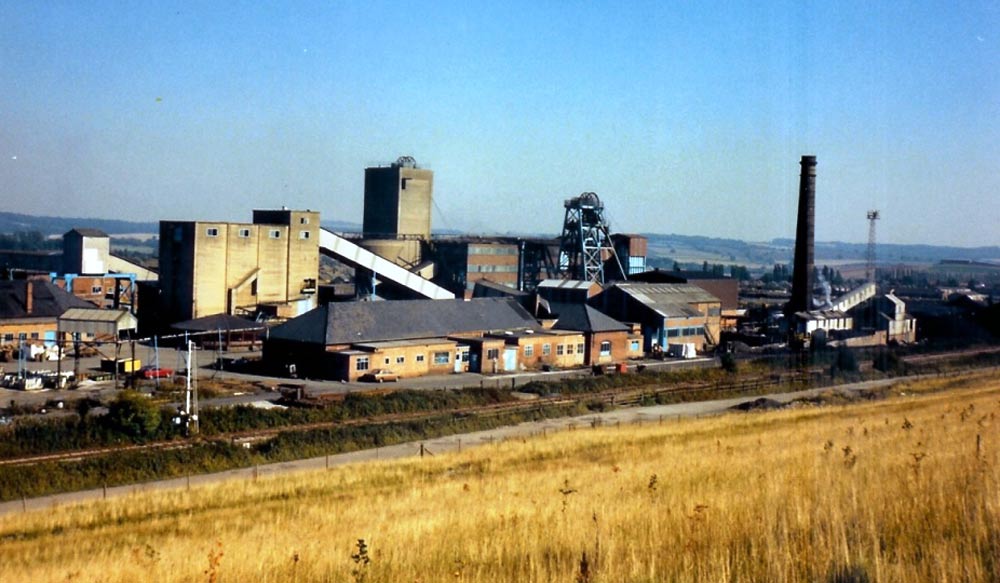
Hucknall, formerly known as Hucknall
Torkard, is situated seven miles north-west of Nottingham on the west
bank of the Leen Valley. Its prosperity was based on coal mining.
Maureen Newton, a local historian in Hucknall, told me:
"We had two pits in Hucknall itself.
Hucknall No.1 (Top Pit) and Hucknall No.2 (Bottom Pit) which employed
the most men. Hucknall men did work at Linby Colliery as it was within
walking distance - but - quite a few others were as well. My mum said
she could stand on the top of the local Misk Hill and see nine
collieries. I have not yet worked out if this is true but there were a
lot in easy reach. In 1861 Hucknall No.1 was the first colliery in the
Leen Valley coalfield and the others followed afterwards."
At its peak in 1963 the
Linby Colliery (above) employed 1,113 men and claimed to be the most productive
coalmine in Europe. The last pit closed in 1986. The "Flying Bedstead",
the prototype of the first Jet-powered Vertical Take-off and Landing
Plane (VTOL) , was researched and tested at Rolls Royce in Hucknall.
Rolls Royce still employ some people but there are no other large scale
employers and most people work out of town in Nottingham or elsewhere.
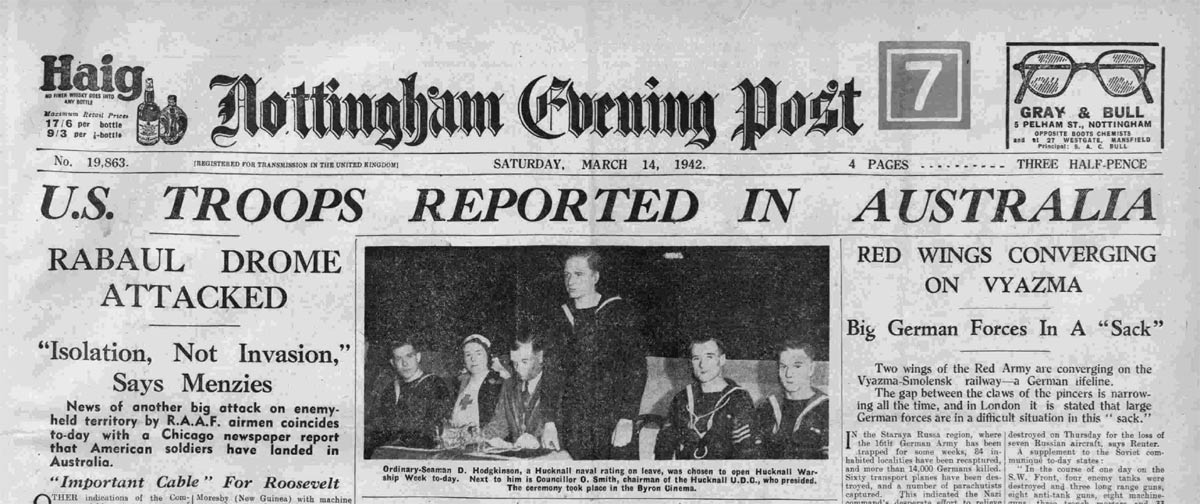 Ordinary Seaman R.D.F. Hodgkinson, a Hucknall naval rating on leave was chosen to open Hucknall Warship Week today
Ordinary Seaman R.D.F. Hodgkinson, a Hucknall naval rating on leave was chosen to open Hucknall Warship Week today
Next to him is Councillor G. Smith Chairman of the Hucknall UDC
The ceremony took place in the Byron Cinema
Nottingham Journal
Hucknall had its own local paper, the
Hucknall Dispatch, but the
Nottingham Journal and the
Nottingham Evening Post (above) began
publishing stories about plans for Warships Week in December of the
previous year by which time the name of the ship to be adopted was
already known and regular updates were published. The following articles are all from the daily
Nottingham Journal.
Monday, 15 December 1941 - For the Hucknall and District Warship Week, HMS
Vimy a destroyer has been adopted. The target is £210,000, and 14-21 March 1942, the week allotted to raise the sum.
Wednesday, 18 February 1942 - Seeing the “big guns" are difficult to get for the opening of Hucknall
Warship Week to commence 14 March, the committee have agreed upon a
novel ides tor the occasion. All the naval man who happen be on
furlough at the time will be marched to the ceremony at the
Byron
Cinema, and the person to declare the decks cleared for action will be
determined by a draw. Mr. F. Seymour Cocks, MP, and local councillors
will be present with military units, sea cadets, and other
branches of the Services.
Friday, 13 March 1942 - Hucknall WW opens tomorrow. The target is £210,000, representing the hull of a destroyer. The ship adopted is
Vimy
and the town is gay with displays linking ‘Vimy with Victory’.
The area covered by the week is Hucknall, Papplewick, Bestwood and part
of Annesley. The opening ceremony will be performed by a local
naval man home on leave, but the actual personage will not be decided
until a short time beforehand.
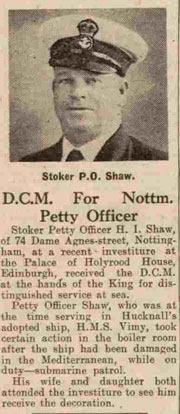 Saturday, 14 March 1942
Saturday, 14 March 1942
The opening ceremony was on unusual lines. Conspicuous in front of the
platform were six local naval men, along with a lady of the. Voluntary Aid Detachment (VAD)
attached to the Royal Navy. From this list Ordinary Seamen R. D. F.
Hodgkinson was selected to declare the Week open, and he wished success
to the effort. Another boy was called upon to announce the promises so
far, and these amounted to £105,250. The target is £210,000 for the
adoption of HMS
Vimy. To each
of the men in the silent service, Councillor G. E. Goodall, chairman of
the Committee, presented a Savings' Certificate. The chair was occupied
by Councillor O. Smith, who said that the target meant £30,000 a day,
but by pulling their weight he felt they would achieve their object.
During the afternoon there was a parade of various detachments through
the town. Up to last night the Carlton campaign had realised £105,000.
A Comforts Fund dance the Western Tennis Club, Derby Road, last night,
was well attended.
Monday, 16 March 1942
The Hucknall Warship Week, the target for which Is £2l0,000 - opened on
Saturday at the Byron Cinema on unusual lines. Conspicuous in the
front the platform were six local naval men along with a member of the
VA.D. attached to the Royal Navy. From this group O/S R. D. F.
Hodgkinson was selected to declare the Week open and wished success to
the enterprise. Another naval man was called upon to announce the
promises, and so far these totalled £105,250. To each of those in the
“Silent Service,” Councillor G. Goodall, the chairman of the committee,
presented a Savings Certificate. The chair was occupied by Councillor
Oliver Smith, chairman the Council. Councillor. W. Reynolds
described the Navy as ‘Their Salvation’ and he hoped that Hucknall
would raise the money not only for the hull of the destroyer Vimy, but
a good deal of its equipment. Mr. F. Seymour Cocks, M.P. tor the
Division proposed vote of thanks to the committee, the group secretary
and the various helpers.
Monday, 26 March 1942 - Including a few interest-free loans, the latest returns show that
£192,350 was realised by the Hucknall Warship Week against a target of
£210,000. Last May during War Weapons Week the town and district
reached £230,000 or £80,000 beyond its target, so to raise nearly
£423,000 within ten months is regarded as a notable contribution.
Friday 27 March 1942 - Hucknall
C of E (Mixed Department) National Savings Association succeeded in
raising £4,180 17s during Hucknall Warship Week.
Thursday 18 June 1942 – Mr G.
E. Goodall presided last night at the final meeting of the Hucknall
Warship Week Committee. The Chancellor of the Exchequer sent a
letter expressing thanks for the free gifts amounting to £32 5s
10d. The expenses of the selling centre were £13 19s 9d, all of
which was met by various efforts, and left a balance of £9 10s.
The exchange of plaques by the Admiralty and Hucknall Urban District Council
The
Nottingham Jouurnal reported
on the exchange of plaques in its issue dated Saturday 29 February 1943
(see below) and in all probability the plaque presented by the
Admiralty to Hucknall UDC was proudly displayed in the Council Offices
until Hucknall UDC was swept away by Local Government Reorganisation in
1974. This replaced 1,086 urban and rural districts with 296 District
Councils and was one of the main reasons why so many of these war
memorial to adopted ships and the men who served in them were lost sold
or scrapped.
Hucknall has no museum and when Hucknall UDC became part of
Ashfield District Council and the Council Offices in Hucknall were
cleared the Hucknall Heritage Society retrieved the more interesting
items to save them from being scrapped. These included the engraved
wooden plaque bearing the arms of Hucknall which was returned to the
town before HMS
Vimy went to
the breakers yard but did not include the plaque bearing a cast iron
replica of the "screen plaque" mounted on the front of her bridge. This
may have been transferred to the District Council Officers in Ashfield
which later moved to Kirby or, perhaps, sold to a collector as they
were thought to be made of bronze and fetched a good price.
I am hopeful that the plaque will be found and reunited with the
plaque presented to the ship and displayed in a public place as a war
memorial where they can be seen by the families of the men who served in HMS
Vimy and the families of the
men, women and children who raised £192,430 in National Savings
during Hucknall's Warship Week to pay for the cost of the hull of a new
destroyer.
Frank Donald was two months old when his father Lt Cdr Colin Donald was killed by a sniper's bullet on the bridge of HMS
Vimy, his first command, while e
vacuating the Welsh and Irish Guards from the besieged port city on 23 May 1940.
Four days later his successor as CO was swept overboard and killed
during the Dunkirk evacuation. Frank Donald followed his father into
the Navy and has been helping me build this website from the beginning.
It was not all death and destruction aboard HMS
Vimy.
About the time when Hucknall adopted this elderly destroyer her crew
awarded their Commanding Officer with the "Order of the Whale" for
depth charging a surfacing whale. The presentation was made during a "
Crossing the Line" ceremony with officers and men dressed for the occasion photographed by AB Robert Holland and sent to me by his grandson.
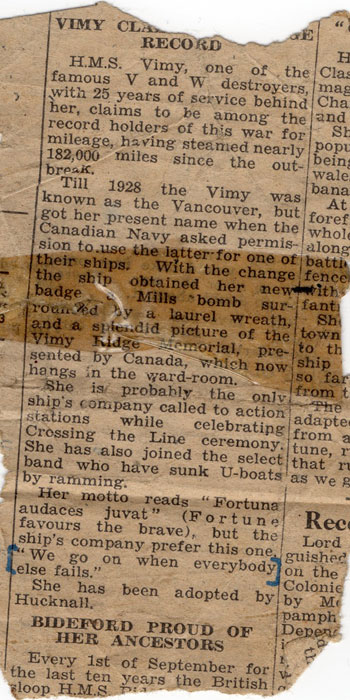
HMS Vancouver was renamed HMS Vimy in 1928
Courtesy of Peter Mcquade, grandson of LS Arnold Ludlow
|
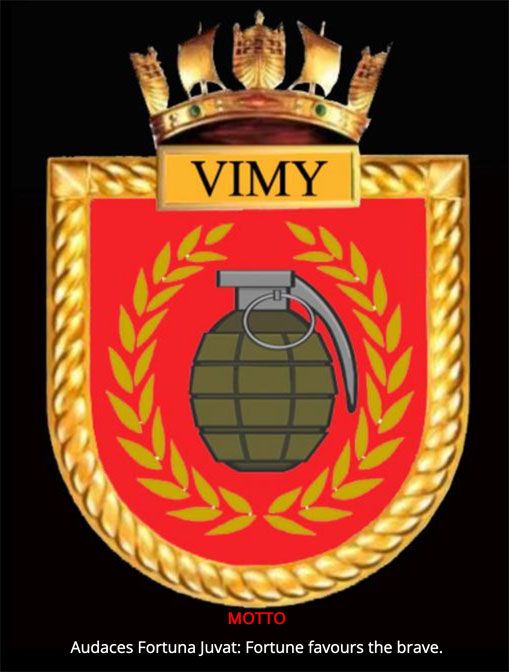
The crest of HMS Vimy was mounted on the wooden shield
presented to Hucknall by the Admiralty after her adoption
Courtesy of HMS Wildfire, Sheerness
|
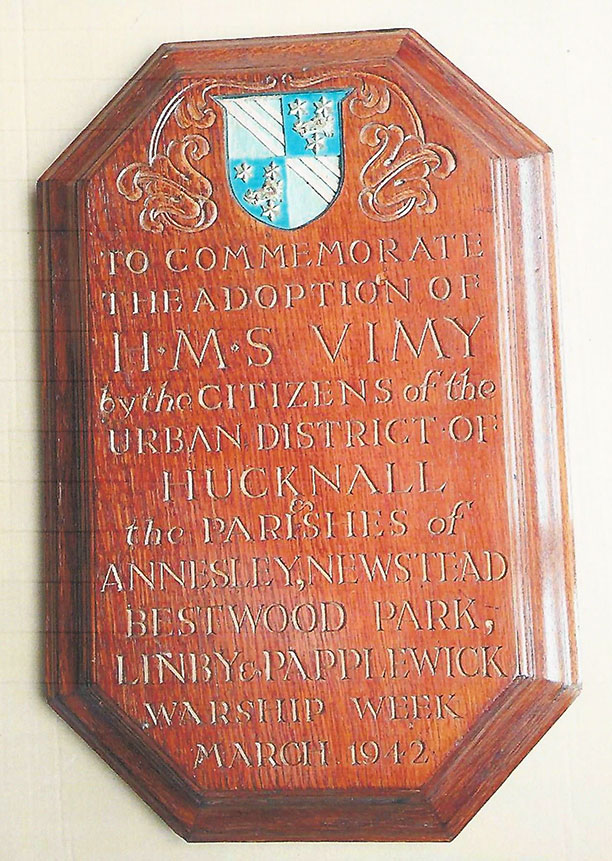
|
The Nottingham Journal
Saturday, 20 February 1943
Plaque For Hucknall - First £1OO for
HMS
Vimy’s Crew
“Presented by the Lords Commissioners of the
Admiralty to Hucknall Urban District
to commemorate the adoption of HMS Vimy during Warship Week, 2 March. 1942."
"Such was the inscription upon
plaque given to Hucknall last right by Admiral Sir William E.
Goodenough in exchange for one from the town. There was a good
muster of towns people at the Church Hall to witness the ceremony which
was presided over by the chairman of the District Council Mr. Oliver
Smith,' who spoke of the successive efforts made by the town since the
commencement of the war, and handed to the Admiral the first cheque of
£1OO for comforts for the crew. Mr. G. E Goodall, who is chairman of
the Savings Committee, also eulogised Hucknall people for their
contribution of £239,000 and £194.000 in respective weeks, added to
which there were weekly Savings to the extent of £5,000. After
the exchange of plaques, Admiral Goodenough gave an address in which he
mentioned that the Navy was bringing across the water 13oz out of every
lb of flour. A dance followed the presentation."
Hucknall raised £229,332 (£10 19s 8d per head) during War Weapons Week and £192,430 (£7 8s 2d per head) in Warship Week.
But where is the Admiralty plaque now?

 HMS VIMY
HMS VIMY

 Saturday, 14 March 1942
Saturday, 14 March 1942

